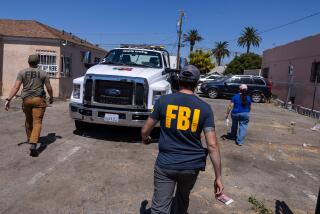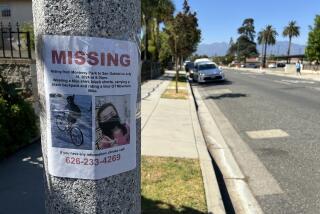An American is missing in Mexico, but his other life emerges
Daniel not come home.
Linda LaPorte stood in the kitchen of her home in Pascoag, R.I., holding her cellphone. Her son’s Thai girlfriend was calling from San Diego, speaking a mile a minute in fractured English.
He said call mom if he not come home.
Linda and her husband, Joseph, had called their son just days earlier to wish him a happy 27th birthday. He’d said nothing about traveling anywhere.
Yet here was his girlfriend saying he’d gone to Mexico on business with a guy named Big Daddy. And he hadn’t come back.
“What she was trying to convey to me didn’t make sense,” Linda recalled.
Dozens of American citizens have been kidnapped and killed in Mexico in the last year. They are a small fraction of the 2,500 people, the vast majority of them Mexicans, who have been slain gangland-style. Countless others have been kidnapped for ransom.
Officials on both sides of the border say the American victims are rarely unlucky tourists. Some lived in Mexico and may have known their attackers. Others were businesspeople who crossed the border regularly and were seen as an easy source of cash. Still others were thought to be involved in drugs.
Linda didn’t know any of that. All she knew was that Dan was missing.
He was the youngest of the LaPortes’ three sons. The other two had married and started families. Dan still hadn’t settled down. He was affectionate and fiercely loyal, but had a troublesome temper. He had few ambitions; after graduating from Burrillville High School in 2000, he got a job in a deli.
In the spring of 2005, he followed his boss to San Diego, “looking for something better,” Linda recalled.
Dan was working at a restaurant and as a bouncer at clubs -- just to pay the rent, he told his family. His plan, he said, was to open a surfboard factory in Mexico. A 6-foot, 1-inch former high school football player who weighed 290 pounds, he began to take better care of himself. He developed a taste for stir fry and Thai cuisine, started working out vigorously and dropped 100 pounds.
He was finding his way in the world, or so it seemed from 3,000 miles away.
Slow down, Linda told Dan’s girlfriend, T.K. Dangalongkon. What’s this about Mexico?
Dan had left for the border Feb. 22, a Friday, T.K. said. He’d looked worried and told her that if he wasn’t back by 10 p.m., she should call his mother. She’d know what to do.
It was Sunday morning now, and Linda had no idea what to do.
She dialed Dan’s Rhode Island cellphone and left a message. She called his California cellphone but couldn’t connect.
She drove to the house of one of Dan’s closest friends. When was the last time he’d talked to Dan? she asked. Did he have the names or phone numbers of any of Dan’s contacts in Mexico? Who’s Big Daddy?
Linda went to all his friends, but got no answers. They seemed evasive.
She called T.K. back and sent her to a neighbor, who helped her file a missing-person report with the San Diego Police Department.
A tearful day blurred to night. Sleep never came.
Linda and Joe got up Monday and went to work: she as a customer service representative for the Pascoag Utility District, he for the Burrillville Public Works Department. It was hard to focus on anything but finding their son.
Linda spoke to the State Department. One of Dan’s friends contacted the U.S. Consulate in Tijuana. Mexican and U.S. authorities promised to scour prisons, jails, morgues, hospitals.
Days passed. Nothing turned up.
Three of Dan’s friends flew to San Diego. They shipped back nearly a dozen boxes of his belongings.
Linda scoured them for clues. She turned out every pocket and pored over the files in his computer, piles of papers. She puzzled over a bill for a shrink-wrap machine, bought in the name of the surfboard manufacturing company Dan said he was trying to start.
In his camera were photos of a trip to Mexico in 2005, riding four-wheelers and swimming in the azure ocean. That was the Mexico she knew. Some photos showed men his mother didn’t recognize; two of them looked as if they might be Mexican. She e-mailed the pictures to a Mexican consular official.
After a week of searching, Linda was right where she’d started. She had no answers, just suspicions.
John Eppick had worked in Mexico for nearly a decade, finding stolen airplanes for American companies, among other assignments. Now, he was intent on retiring after more than 40 years as a private investigator. He and his wife had bought a wooded property in Missouri with a fish pond.
His wife was still in California in March when she ran into a male acquaintance. The man had a friend in Rhode Island who needed a private investigator to work across the border. Was Eppick still taking cases?
Some, his wife replied.
Linda took a shot.
“Most of the other telephone calls I refer to other investigators,” Eppick said. “This particular one concerned me because I was well aware of the problems in Tijuana and Rosarito.”
Eppick told the LaPortes that the investigation was likely to take a month and cost $25,000, maybe more.
It was nearly 10 p.m. on March 5, two weeks after Dan had disappeared. Linda hung up the phone and faxed Eppick a copy of Dan’s passport and car registration, financial records, every piece of paper that looked even remotely significant: 75 pages of what she knew about her son’s last days.
“You have to allow for three scenarios,” Eppick recalls thinking. “One, they just flat-out shoot you. Two, they kidnap you and torture you. And three, they kidnap you for ransom.”
Eppick was well-informed about the lawlessness sweeping Mexico: the running gun battles between drug gangs, the daylight ambushes of police and justice officials, the innocent victims of automatic-weapons fire -- wedding guests, a baby, a teenage girl.
Eppick hired two investigators in San Diego. They reached out to police there and in Mexico, took out newspaper ads and posted fliers with Dan’s driver’s license photo and a description of his 1999 green Cadillac STS.
Eppick called his contacts in Mexico, interviewed Dan’s friends in Rhode Island and flew to San Diego to talk to anyone he could find who knew the missing man. A picture of Dan’s life emerged. It was not the life he had told his parents about.
According to the information Eppick gathered, Dan did not work in a restaurant. He was not a bouncer. Dan trafficked in marijuana.
Eppick estimates that Dan purchased 2 to 4 tons of the drug each year during trips to Mexico. Dan would repackage the marijuana in 2- to 3-pound bundles and mail them to Rhode Island, where associates would sell it, Eppick said.
“I was just numb,” Linda said. “It’s not true. It’s true. It’s not true. How can it be true? We never saw signs of it. Then you think back to little instances here at home.”
She knew Dan and his friends smoked marijuana. She had argued with Dan about it when he lived at home. Once, she’d followed a humming sound to the closet of the guest bedroom and found a dozen pot plants swaying under a fan. But that was just adolescent foolishness, she remember thinking.
“There were no bales in the cellar, no fake floorboards, no exorbitant amounts of money,” Linda said. “He’s a TJ Maxx and a Marshall’s shopper.”
There was the Cadillac. But he’d bought it used. And the surround-sound system in his living room.
Dan came home twice a year -- once for several months -- and was able to hang around with her when she visited him in San Diego in 2006. But he explained away his free time: He said he’d switched shifts. That didn’t seem unreasonable.
“I’m still trying to wrap my mind around some of the things John told us,” Linda said.
Eppick sent Linda to the Internet to read about Tijuana’s Arellano Felix cartel. She soaked up page after page of information about the drug violence gripping Mexico.
“Talk about being a babe in the woods,” she said. “I had no idea.”
After weeks passed without a demand for ransom, Eppick ruled out kidnapping. He figured there were two possibilities: Either Dan was dead or he was being tortured.
Eppick developed a theory of why Dan had gone to Mexico. His confederates in Rhode Island owed him at least $140,000, he said. Dan could have been called to answer for the missing money. Maybe he was killed for it.
A parking receipt showed that Dan’s Cadillac had been parked Feb. 22 in a well-lighted lot in San Ysidro, where thousands of Americans leave their cars to walk across the border into Mexico. The car was claimed the next day by a person or persons unknown.
“It kinda gave you a little bit of hope,” Linda said. “Maybe he was still alive.”
In May, three men hunting small game came upon a grisly site near Rosarito Beach, Mexico, a resort town popular with U.S. college students and retirees that has been lightly touched by the drug violence.
The hunters stumbled upon a green car pocked by automatic-weapons fire, with two bloated corpses in the back seat. Two more lay crumpled in the dirt on opposite sides of the car, apparently cut down as they ran for their lives.
The dusty car was a 1999 Cadillac STS with California plates.
A San Diego TV reporter called the LaPorte family about the discovery. Linda tried to still her heart.
On the Web, she saw news photos of the car with blood splashed on the seats, the body of a woman face-down on the ground. Linda made out a few of the numbers on the license plate. It was Dan’s car.
But he was not among the dead.
Three of the victims were Mexican nationals with criminal records who had been deported from the United States: Juan Jose “El Lumpy” Olivares, Antonio “El Kilo” Virgen and Franciso “Pancho” Javier Garcia. The fourth was Libe Craig, a San Diego native of Mexican descent with a history of drug and weapons offenses.
Lead detective Ricardo Groves of the state police said the four were known to hang out at a clubhouse in Rosarito Beach where deported gang members and other convicts made drug deals and got high.
None of the dead were known to be friends or associates of Dan’s. But Virgen, Libe Craig’s boyfriend, had been driving the Cadillac for weeks and had tried to sell it, Groves said. He had Dan’s keys.
As a deportee, Virgen might have had a hard time getting into the U.S. to pick up the car. Craig wouldn’t have.
Craig, 28, had spent a year in a Tijuana jail for weapons possession, Groves said, and records show she had two convictions in San Diego for possession of crystal methamphetamine. A relative said the addiction stole Craig’s dreams of becoming a pediatrician, ruined her marriage and cost her custody of her daughter.
Craig, Virgen and the others had recently graduated from trafficking in drugs to ripping off other traffickers and selling the stolen drugs, Groves said. Confidential informants have reported that they were planning to pull off their second such theft on the night they died.
Dan’s missing-person flier was hanging in the cramped Rosarito Beach office of the Mexican attorney general when Eppick arrived June 2. As he spoke with Groves and Comandante Rafael Gonzalez, a new puzzle piece emerged.
Unidentified remains had been dumped in an industrial barrel of acid in a ditch between two housing developments in Rosarito. The blue plastic container had apparently been hit by a car and tipped over, spilling a mess of partly dissolved bones. The discovery was reported by an anonymous caller Feb. 24, two days after Dan disappeared.
Groves had sent the bones for DNA analysis by Mexican authorities, but there was nothing to compare them to -- yet.
Eppick returned to San Diego and dashed off an e-mail to Linda.
“NOW HOLD ON, LINDA,” he wrote. He went back to Rosarito the next day to determine whether DNA from the bones could be compared to samples from Dan’s parents.
Linda and Joe swabbed the insides of their cheeks and sent the samples to the San Diego Police Department, which forwarded them to a California state crime lab.
Once technicians developed genetic profiles from the samples, they could be compared with the DNA profile from the bones.
Then bureaucratic complications arose. To send a DNA analysis of the LaPortes’ samples to Mexico, U.S. authorities would have to go through Interpol, a potentially lengthy process.
San Diego police devised a faster way. They asked for fresh swabs from the couple and, on Monday, handed the samples to a Mexican official at the border. A crime lab in Tijuana will compare the genetic profiles. Results are not expected for weeks or months.
“There are two parts of me. My heart says to hold on,” Linda said, sobs breaking through her attempt at calm. “My brain is telling me that the DNA will be a match.”
The search for their son has cost the couple more than $100,000. Once debt-free, the LaPortes have gone through their savings and taken out a line of equity on their home.
Linda can barely talk about her son without crying. Thoughts of him intrude at work.
“At this point, I’ve lost plenty of sleep already. I just want him home,” she said. “I don’t think I’ll ever have an answer as to what exactly happened to him -- if that is him.”
Anyone with information about the disappearance of Daniel LaPorte is asked to call the San Diego Police Department at (619) 531-2000.
More to Read
Sign up for Essential California
The most important California stories and recommendations in your inbox every morning.
You may occasionally receive promotional content from the Los Angeles Times.










